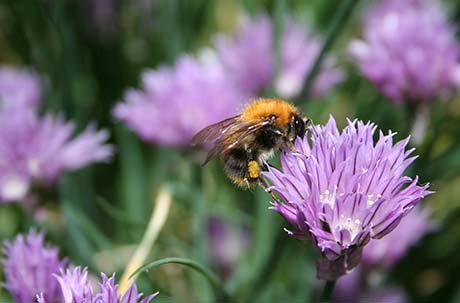- Lavender
- Cherry trees
- Lilies
- Sunflowers
- Heather
- Hyacinths
- Geraniums
- Apricot trees

Bees are essential to biodiversity and life on Earth. They play a fundamental role in the ecosystem, and carry out nearly 80% of the pollination of plant species.
Despite the importance of these natural workers for all biodiversity, alarm bells have been ringing for many years: bee populations are declining! We all have a role to play in addressing this issue, by taking simple actions. Discover 5 tips to contribute to the well-being of our pollinating friends from your garden or terrace!
To make sure you attract bees to your garden, feed them! How can you do this? By planting and sowing bee-friendly plants: plants whose flowers produce a lot of nectar or honeydew which bees collect to make honey.
A small Pink Lady® tip: remember to choose plants that flower at different times of the year and that are native to your area. That way, the bees will be able to feed all year round. Finally, plant and sow a variety of plants. For example, combine flowers, shrubs, fruit, vegetables or herbs so that different species of bees will be attracted to your garden.
Here is a non-exhaustive selection of plants that bees love:

The second point which cannot be ignored when it comes to welcoming bees is shelter. Offer your winged friends (especially so-called « solitary » wild bees) a proper shelter by making a beautiful insect hotel so that they may store nectar and lay their eggs there.
If you already have an insect hotel, simply add a few wooden blocks with holes of different diameters, hollow stems (reeds, bamboo, knotweed, etc.), but also bricks or hollow clay blocks.
Third tip: stop using pesticides! If you want to protect bees, you must grow a 100% organic garden. If you haven’t already done so, ban pesticides from your gardening routine. Bees are suffering from the increasing use of pesticides.
Many natural alternatives can be used to make sure your garden remains harmonious, and to grow things the organic way, such as pulling weeds by hand, or introducing ladybirds to eat aphids in the garden.
A patch of wilderness in your garden will provide natural shelter for bees, but also for many other pollinating insects (wasps, butterflies, etc.) and animals (frogs, hedgehogs, birds, etc.) that are essential to the biodiversity and ecological balance of your garden.
These wild areas allow bees to take refuge, feed and reproduce. Such natural shelters are becoming increasingly rare and animals and insects love them for their calm and stability.
Bees need to feed, but they also need to drink. So think about setting up a small, shallow watering point (a bowl), surrounded by stones (to prevent them from drowning) and place it near the flowers.

In the hot dry season it is essential to fill it regularly as bees stop collecting pollen and look for water instead. Under these conditions, bees have been estimated to bring back about 3 to 4 litres of water per day to the hive.